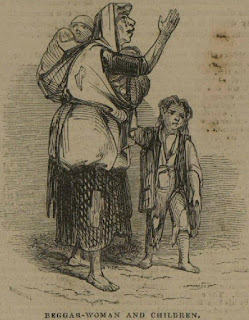Charles Bianconi changed all that. He was the Michael O'Leary of his day. Having arrived here in 1800 as a door-to-door salesman of Italian engravings, he soon saw the need for faster coach transport. His Bianconi Coach business had humble beginnings. in 1815 he started with just two coaches (called Bians), each carrying 8 passengers, sitting back to back, face out to the roadside, in 2 rows of 4 longitudinally on a hard bench, plying between Clonmel and Cahir.
By 1850 he had revolutionised public transport around Ireland, managing some 100 vehicles, which traveled an astonishing 3,800 miles daily, calling at 120 towns, and 140 stations for changing horses. Each of these 'stations', many of which were hotels, inns or public houses, employed several grooms and a farrier, not to mention the catering and other people involved. With over 500 drivers on the payroll and 200 'Bians' in the fleet, they kept over 1,300 horses to pull the cars, that ate around 3,500 tons of hay a year, plus 35,000 barrels of oats. Bianconi also owned a coach-builders company in Clonmel where they made and repaired their own fleet of coaches, and also contracted to dozens of tradesmen and harness-makers, as well as establishing a network of over a thousand ticket-vendors all over the country.
Blacks Hotel in Eyre Square Galway, Ireland was the Bianconi station in the city (now the Imperial Hotel). The Central Hotel In Loughrea, owned by J. Salmon was the Marconi depot there. A laden Bianconi Royal Mail Day Car or Coach covered about 8 miles per hour and passengers were charged one penny and a farthing per mile (about a 1/2 cent nowadays).
The fare from Galway to Clifden was 7 shillings and six pence (about 30 cents today) and took 11 to 12 hours to cover the fifty-odd miles! And you sat outside, in all weather! Coaches to Dublin took 2 days, with passengers staying overnight in places like Athlone or Kilbeggan.

They carried mail, passengers and trade-goods. Bianconi's coaches helped the revive the fishing industry by allowing fish caught today in Galway or Cork, to be sold in Dublin within 24 hours, by driving 24 hours straight with perishable cargo.
The mass migration of the Irish people ignited by The Great Famine brought huge increases in passengers, who used Bianconi's services to reach the ports from which they emigrated to England, Canada, America and Australia. The departing emigrants would have passed harrowing scenes of poverty, beggars, evicted families, demolished or uninhabitable homes and lean-to's on the sides of the roads, no doubt reinforcing their decision to leave their native land.
The Railways finally put the Coaches out of business in the final years of the 19th century, though these new rail-lines, while they provided huge employment in their building, only helped spur and enable more emigration from Ireland..
Today you can still see some Bianconi Coaches in use as jaunting cars on Killarney.
Charles 'Carlo' Bianconi, who brought cheap public transport to Ireland, died in 1875 and left his company to his employees. A truly modern, innovative and patriotic Irishman, though he was born 130 years ago in a little village called Tregolo, in northern Italy, in 1785.
Hope you enjoyed this post. If you'd like to hear more Galway stories, check out my website www.galwaywalks.com or my Facebook page www.facebook.com/galwaywalks or follow me on Twitter @galwaywalks
Regards
Brian Nolan
Galway Walks
Galwaywalks@gmail.com










No comments:
Post a Comment